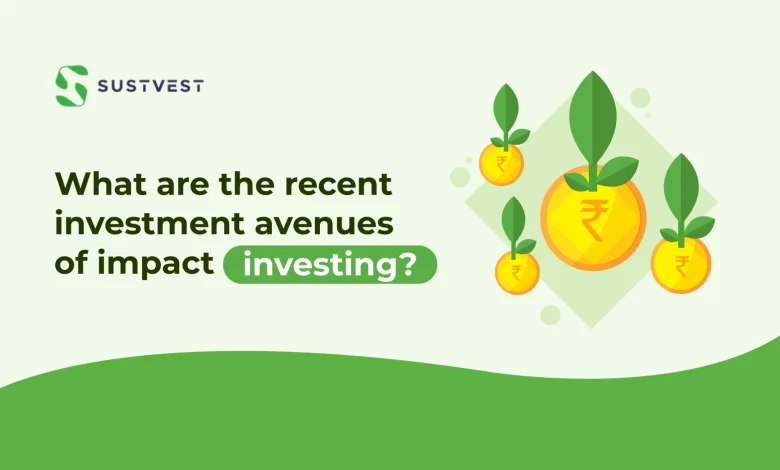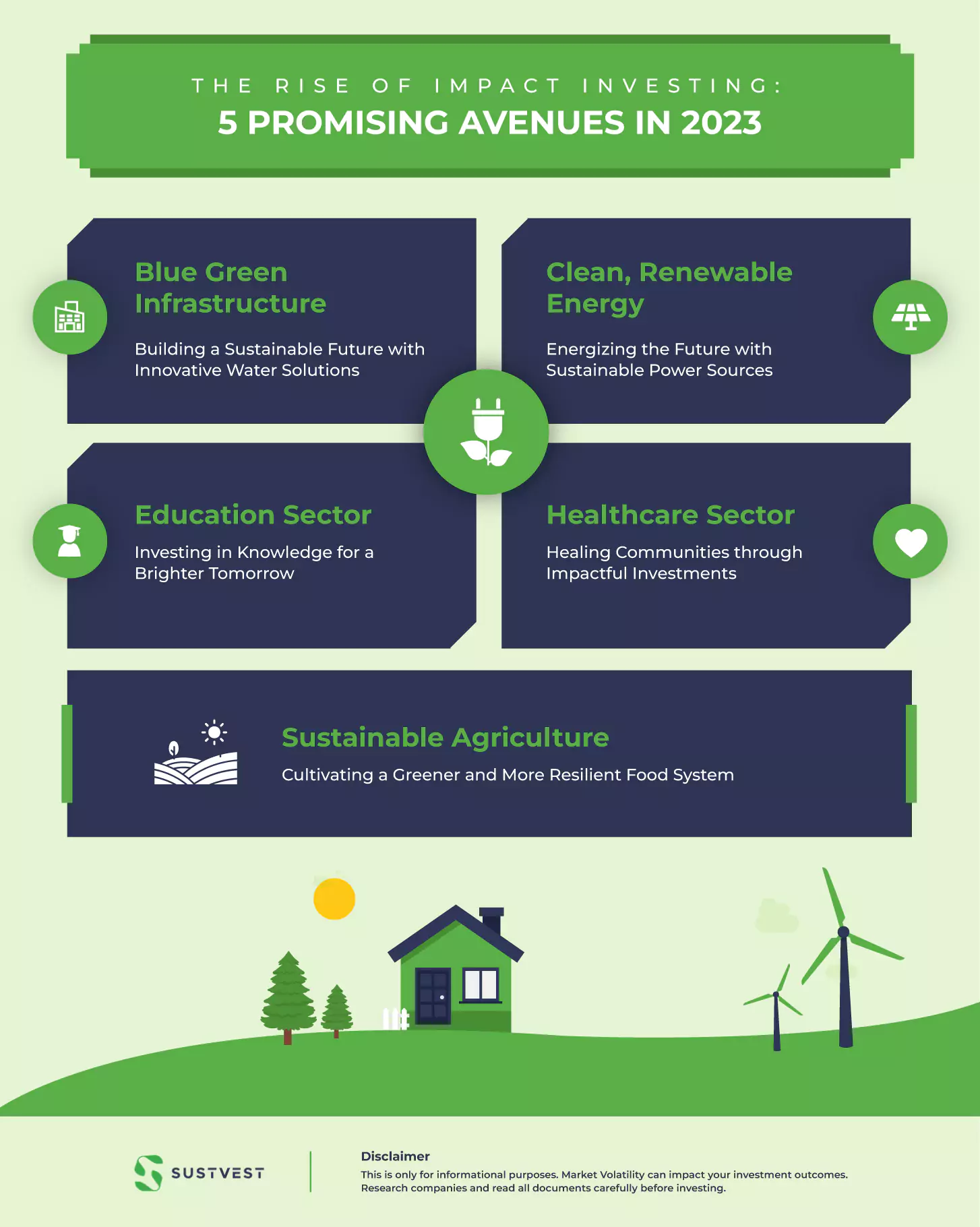Revolutionizing Finance: Impact Investing in 2023

Introduction
Picture investments that secure your financial future while nurturing a sustainable planet for generations to come in a world craving change.
Impact investing, a creative fusion of philanthropy and finance, embodies this vision. Coined by the Rockefeller Foundation in 2007, it initiated a revolutionary shift—a quest for balance between purpose and profit.
In today’s world, the Earth faces challenges, despite most investing for retirement, leisure, or unforeseen medical needs. Though it may seem abundant, rising pollution and carbon emissions threaten its habitability.
Impact investing is no longer exclusive to the wealthy; it’s accessible to anyone with a vision to invest in social and environmental issues. Together, we can foster progress, seize opportunities, and pave the way for a future where fossil fuels are but a memory.
Come along with and explore the newest impact investing opportunities for 2023. Each is a step towards a better future.
The Rise of Impact Investing: 5 Promising Avenues in 2023
Impact investments have become increasingly important in the post-pandemic era, which resulted in new investment opportunities that priorities both financial returns and environmental sustainability.
Below are 5 impact investing current investment options:


1. Blue-Green Infrastructure: Paving the Way for Sustainable Urban Living
Urban planning and design are being approached in a novel and creative way using Blue-Green Infrastructure.
The phrase “green infrastructure” refers to a variety of construction initiatives, such as parks, green roofs, rooftop solar arrays, green corridors, and vertical and horizontal gardens.
The blue component of infrastructure, on the other hand, emphasizes effective water management, waste management, and water harvesting.
But why has Blue-Green infrastructure only recently become more popular among impact investors?
Why Is Impact Investing’s Newest Investment Avenue in Blue-Green Infrastructure?
Due to its focus on addressing climate risks and promoting inclusive, secure, and resilient cities that are in line with SDG 11(Sustainable Development Goal number eleven), blue-green infrastructure is an underutilized investment option in the field of impact investing.
India’s Blue-Green Investments
Cities like Delhi, Bangalore, and Bhopal have started incorporating blue-green infrastructure into their urban planning, albeit it is still in its infancy in India. For their sustainable activities, businesses in India have been successful in attracting private investment:
- SustVest: Specializing in renewable energy, istanbul yeni escort including rooftop solar systems, SustVest links private investors with green energy projects. A minimal INR 15000 investment can yield returns of 10-15%.
- Ekam Eco Solutions: This business focuses on decentralized wastewater treatment, recycling tech, and eco-friendly water management.
- Uravu Labs: Offering resilient water solutions for residential, commercial, and industrial projects, Uravu Labs ensures pure drinking water using innovative tech like infinite atmospheric moisture and renewable sources like solar and biomass.
These businesses showcase growing private investment in sustainable Blue-Green Infrastructure projects.
2. Clean, Renewable Energy: Energizing the Future with Sustainable Power Sources
Given that India is expected to overtake China as the most populous country, renewable energy has enormous potential to meet the country’s expanding energy needs.
Furthermore, the twin benefits of renewable energy include reducing the excessive post-COVID energy demands and eventually displacing fossil fuels by 2070.
Let’s examine the patterns of clean energy investment.
Investment Trends in Clean Energy
With a startling $14.5 billion investment in 2021 alone, clean energy has received a lot of attention and surpassed expectations. India is expected to resurrect global energy investments worth $2.8 trillion by 2023 as dependence on fossil fuels declines, while investments in coal, gas, and oil already total $1 trillion.
Leading companies in India are aggressively investing in renewable energy:
- Mukesh Ambani intends to invest $10 billion in solar and wind energy over the next three years
- Adani Enterprise has pledged to investing $20 billion over the next ten years.
Large corporate investments are transforming impact investing, building trust and attracting more funding. This accelerates infrastructure and renewable energy projects.
Renowned investors bring expertise, innovation, and cost-efficiency. Retail investors gain easier access to renewables through stocks and ETFs.
3. Education Sector: Investing in Knowledge for a Brighter Tomorrow
Investing in education aligns with Sustainable Development Goal 4, promoting quality education for all.
Impact investments help communities become more empowered for a sustainable future, close educational gaps, improve teaching, and ensure inclusive access.
Why Is the Education Sector an Investment Avenue of Impact Investing?
The education sector gained to prominence in the impact investment space due to the increase of ed-tech resources during COVID-19, which helped close the urban-rural education gap.
Impact investors are aware of the possibility of financial gains while advancing education. India’s demographic expansion highlights the importance of funding credible ed-tech companies in order to influence the future of the country.
Investment Analysis in Edtech
With COVID-19 serving as a catalyst and driving Indian ed-tech businesses to unicorn status globally, edtech has seen amazing growth in India.
With more than 4,500 ed-tech businesses working within India’s vibrant startup ecosystem, more than $2 billion was invested over the course of the last year and more than $5 billion over the course of the previous five years.
4. Healthcare Sector: Healing Communities through Impactful Investments
A notable sector for impact investing is healthcare, which is in line with Sustainable Development Goal 3. By 2030, this objective seeks to safeguard global health by putting an end to epidemics like AIDS, TB, and malaria.
The possibility for profit generation while having a beneficial societal impact in the healthcare industry, driven by technological improvements, attracts impact investors.
Why is Impact Investing’s most recent investment avenue in the healthcare sector?
The healthcare sector’s prowess in early disease detection and life-saving treatments makes it a vital area for impact investment. Impact investors are drawn to its potential to enhance health and save lives, making it a compelling choice.
Finances for Healthcare Statistics
The healthcare sector saw a substantial influx of investments during the COVID-19 pandemic, totaling $14 billion for medical equipment, online pharmacies, and digital apps.
Before the pandemic, healthcare tool sales surged 13-fold from $94 million in 2011 to $1.275 billion in 2016. Private healthcare investments tripled to $1.5 billion, showcasing its impact investing potential and capacity for positive societal change.
5. Sustainable Agriculture: Cultivating a Greener and More Resilient Food System
Sustainable agriculture, often overlooked in impact investing, holds immense potential. Aligned with SDG 2, it targets hunger, food security, and sustainable agriculture by focusing on eco-friendly methods and end products, differentiating it from conventional agriculture.
Why is Impact Investing’s most recent investment avenue in sustainable agriculture?
Investing in sustainable agriculture has recently become a popular option for impact investors as the need for more environmentally and socially responsible agriculture becomes increasingly evident. Through this route, farmers are fairly compensated, and consumers enjoy honest fresh product.
Private Investment Towards Sustainable Agricultural Startups
Sustainable agriculture startups have attracted growing private investments. Between 2013 and 2017, agri-food startups raised $1.66 billion across 558 deals, comprising 10% of global deal activity, totaling nearly $17 billion.
For instance, Humpy Farms, an organic farming startup, recently secured INR 5 crore in funding. They practice climate-smart regenerative digital organic farming to reduce their carbon footprint.
The Lesson: The Road to Mainstream Investment for Impact Investing
As India approaches a $3.75 trillion GDP, the urgency of making the Earth habitable for future generations grows.
While venture capitalists, private investors, and equity firms were early adopters of impact investing, individual investors are increasingly interested.
Platforms like SustVest lead the way, despite limited e-Mutual Funds and stock alternatives. SustVest specializes in renewable energy projects, offering individuals the opportunity to support sustainability while earning up to 15% in financial returns.
It’s essential to explore these options to align your financial choices with a more sustainable future.
Conclusion
In the age of impact investing, financial success and positive social and environmental change are not mutually exclusive. The investment avenues discussed here exemplify the convergence of profit and purpose, promising a brighter, more sustainable future for us all.
FAQs
1. What is impact investing?
Impact investing is an investment approach that combines financial returns with positive social and environmental outcomes. It seeks to generate profit while also making a meaningful contribution to society and the planet.
2. Why is impact investing important in 2023?
In 2023, impact investing gains significance as the world grapples with environmental challenges and social inequalities. It offers a path to address these issues while securing financial returns.
3. Can individual investors participate in impact investing?
Yes, individual investors can participate in impact investing through various avenues, such as impact-focused mutual funds, stocks of sustainable companies, and platforms that connect investors with impact projects.
4. How can impact investing benefit society and the environment?
Impact investing can benefit society by addressing critical issues like education, healthcare, and clean energy. It benefits the environment by supporting sustainability initiatives, such as sustainable agriculture and green infrastructure, which reduce ecological harm.






